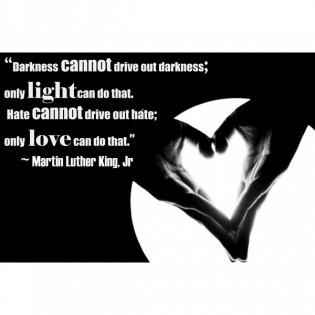Bringing Us Together
The conversation centers on bringing individuals together in community, as they learned from Dr. Martin Luther King, Jr. We each have individual strengths, and we are stronger together as we share our hopes for a world united in generosity for all. The children bind individual pages together into a book that teaches others about hope, kindness, and unity.
The learner will:
- create a collaborative picture book of what we can do for the common good.
- paper and art materials
- book-binding materials
Children take home their enthusiasm for doing something for the common good. Encourage them to find something they can do with their families for the common good.
Instructions
Anticipatory Set:
Ask, "What holds a book together?" Show examples of different ways that books are held together (stitched, spiral, glued, stapled, etc.). A book is made of many individual parts brought together. Our community is also made from many parts to work together for the common good. Today we are going to talk about actions that bring us together stronger. We will put these ideas together in a book, and share the ideas with others.
Brainstorm words that describe the person or the efforts of Dr. Martin Luther King, Jr. Write the words on separate index cards.
Place two circles—such as hoola hoops—on the floor and gather the children around the circles. Put an index card label above each circle: "Martin Luther King, Jr." and "Our Group." Place all of the index cards with words written on them in the MLK circle.
Now they brainstorm words that describe the children as a group and the work they do. Write their ideas on index cards and put them in the second circle. When children see that some of the words are the same as in MLK’s circle, unite the two circles so they intersect in a Venn diagram. Encourage them to move the cards (and add to them) so some words describe just them, some describe just MLK and some describe both sets. Reinforce the concept that they are united with MLK in a desire to promote the common good.
Ask the children to think of ways they personally can continue the work of Dr. King (e.g., helping a neighbor, inviting a new child to play, playing fairly, speak up when they see unfair treatment such as bullying, cleaning up shared spaces, etc.). List the ideas on the board.
Each child draws one of the ideas, illustrating and labeling something they can do for the common good.
Laminate the pages, if desired, and put them into a class book.
The children present the book to another group or a library. Their goal is to spread the message that working for the common good binds the group together and extends the good work of Martin Luther King, Jr.
Philanthropy Framework
-
Strand PHIL.I Definitions of Philanthropy
-
Standard DP 01. Define Philanthropy
-
Benchmark E.1 Define philanthropy as the giving and sharing of time, talent, or treasure intended for the common good.
-
-
-
Strand PHIL.II Philanthropy and Civil Society
-
Standard PCS 02. Diverse Cultures
-
Benchmark E.2 Discuss the importance of respect for others.
-
Benchmark E.3 Identify the similarities in philanthropic behavior among people of different cultural backgrounds.
-
Benchmark E.4 Demonstrate listening skills.
-
-
-
Strand PHIL.III Philanthropy and the Individual
-
Standard PI 01. Reasons for Individual Philanthropy
-
Benchmark E.4 Give an example of how citizens act for the common good.
-
-
